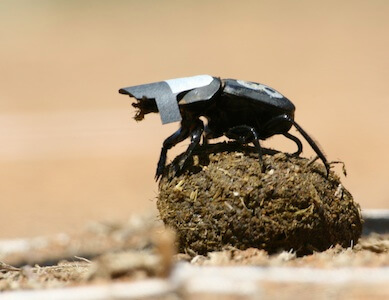Until now, several animals were known to use the stars to navigate, but this is the first time that the light of an entire galaxy has been used.

Insects with tiny brains and minimal computing power turned out to be the first species to use milky way for orientation. Scientists from South Africa and Sweden have published findings showing the connection between dung beetles and the concentration of stars that make up our galaxy.
Because dung beetles' eyes are too weak to distinguish individual constellations, they use the difference between light and darkness provided by the stretch of the Milky Way on a clear night to ensure that they push their eggs in a straight line rather than in a circle, so as not to return to the territory of their dung heap competitors.
Dung beetles don't care which way they go. They just need to stay away from the fight for food in the faeces pile," said Prof. Marcus Byrne from Wits University.
Byrne and his team have previously demonstrated that dung beetles use sunlight, moonlight and polarized light for orientation. In their experiments, they dressed the beetles in "hats", which blocked the light from reaching their eyes. The team also discovered that the beetles climb on top of dung balls that they collect for food needs to perform an "orientation dance" during which they locate light sources and use them to find their way. Now, further experiments, conducted under the simulated night sky of the Wittes Planetarium in South Africa, have shown that the beetles also use the glow of the Milky Way, giving new meaning to the term 'dancing with the stars'.
Not all light sources are equally useful landmarks for a dung beetle. By keeping a constant angle between the beetle and the candle flame, the beetle will move in a circle around the flame. However, a celestial body is too far away to change its position relative to the dung beetle as it rolls the balls, with the result that the beetle maintains a straight line motion.
The scientists suspect that the beetles have a hierarchy of preferences when it comes to available light sources. So if the moon and the Milky Way are visible (at the same time), the beetles will probably use one source and not the other.
So far, scientists have proven that several other animals use the stars for orientation, but dung beetles are the first animal to make use of the entire galaxy.

4 תגובות
There is no God apart from God!
There is no god but Allah..
Greetings,
I often came across the common dung beetle in my house, and every time I tried to get rid of it, I often felt a strange smell that the beetle secretes as a response to fear... I tried to look for information on the subject, but I couldn't find it! Thank you if you tell me if there is anything to do with the scared beetle! Happy spring holiday!
In our world everything works in the sense of give and take, it is interesting to know if there is a reciprocal relationship here, that is, with the macro affecting the micro, does the micro also affect the macro? 🙂
It is interesting that among the ancient Egyptians the beetle was among the symbols of the sun god who rolls the sun across the sky.